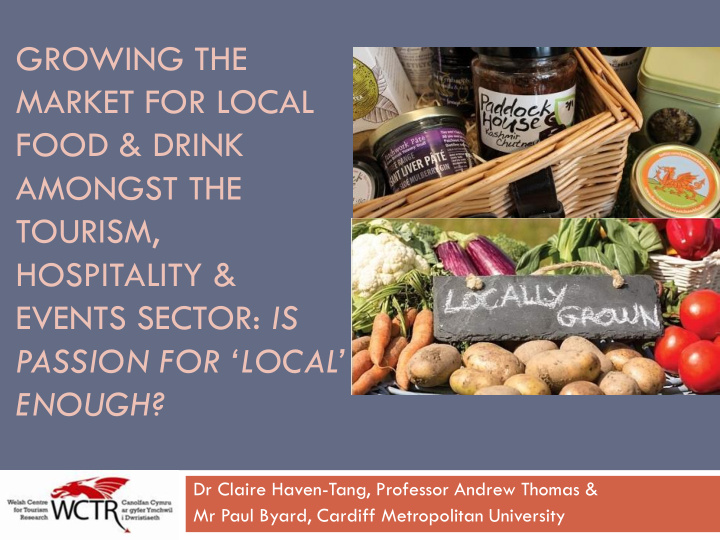



GROWING THE MARKET FOR LOCAL FOOD & DRINK AMONGST THE TOURISM, HOSPITALITY & EVENTS SECTOR: IS PASSION FOR ‘LOCAL’ ENOUGH? Dr Claire Haven-Tang, Professor Andrew Thomas & Mr Paul Byard, Cardiff Metropolitan University
Presentation structure Importance of local food & drink Aim and research approach Supply & Demand Challenges Passion Identifying local food & drink producers Producers – confidence and skills gaps Recommendations
Food traceability and provenance (Groves, 2001) -tourists and locals – appreciate the origin of their food Conversion - production to consumption space Food scares Debates about agricultural & food processing methods Recognition that local food and drink enhances the experience allowing the THE industry to achieve a competitive advantage Raising the profile of high-quality food & drink producers Supporting local artisan food & drink producers Stimulating enthusiasm for local food Re-establishing trust and re-connecting producers and consumers More local food consumed locally creates short food supply chains (SFSCs) Local food & drink not restricted by the inseparability which applies to most THE products, e.g. export opportunities
Food & drink producers in Wales are typically independent micro-businesses – 81% have 1-9 employees Only 37% have a business plan 74% of producers refer to their products being ‘Welsh’ in marketing/packaging (Welsh Government, 2014) 46% of food & drink producers are a current supplier to the THE sector (Welsh Government, 2014) But … . 35% have never considered supplying the THE sector Huge opportunities - Welsh food festivals, are now estimated to generate a direct impact of £7 million per year 38% of food festival evaluation respondents reported that they had started selling new products as a result of their attendance at a food festival (Wavehill, 2015)
Aim of this study The overall study Welsh Food Supply Chain sought to identify the key challenges & issues faced by food companies and to determine how prepared they are to tackle future operational challenges. As part of that, our specific aim was: To explore supply and demand challenges that hinder the growth of the local food and drink market amongst the THE sector.
Research Approach Exploratory qualitative study: Seven semi-structured interviews: Four tourism/hospitality/events operators Two local authority tourism officers and one RDP officer in Southeast Wales: Bridgend & Monmouthshire Secondary content analysis
Findings Passion for Welsh ingredients, with an emphasis on quality: The Welsh food we offer is world- class food. I’ve worked with a lot of the producers over the years so I know a lot of them personally and I’ve always championed their food We try and make an emphasis as much as possible on sort of using probably the major component of a dish making it Welsh ..Having a Welsh-influenced menu is very important Events, e.g. National Eisteddfod, promote the ‘best of Welsh’ in their F&D offer Catering concessions declare how much of their menu is locally sourced Designated area for promoting Welsh beer and cider
Passion for Welsh ingredients did not always translate into actual behaviour…Why? Food might be an intrinsic part of the venue, but not the main pull factor We’re a kind of an ‘also’ rather than the ‘be all and end all’ of somebody’ s trip. Local supply chains: dominance of micro-businesses, geographically dispersed and fragmented, distribution networks Because of what we do here in terms of meal offerings…at any one time we can be providing a lot of food. So it's very hard, the classic is chicken breast, you might be able to find a small farm but it can only provide you with 40 chicken breasts a week. That’ s not going to allow consistency for delivery… Most local producers would not be able to supply us with the amounts that we need. It’ s a nightmare…we’ve got separate suppliers for different animals, we get them from different places. Loads of work, loads of effort going down the market in the morning Delivery can be an issue for many farms …… drivers, you've got to sort out the delivery schedule, delivery van, tax, insurance, petrol.... it is another headache. Cost There are lots of factors that drive what you buy……price, demand and supply……………... I find it amazing that we can get lamb from New Zealand cheaper here than we can get lamb that’ s right outside our door.
Skills gaps Many producers are not skilled at branding, packaging & product development Strong products but lack confidence and sales skills Impacts on business-to-business relationships & hinders growth amongst THE I find that small- scale Welsh producers, it’s like trying to break down a brick wall. They don’t reply and I am spending over a million pounds a year on food A lot of farmers drop out of the farmers’ markets once they actually come to sell their own produce….they lose all confidence and can't do it… Even though ... up to that point they've had every confidence in what they’ve produced. As soon as they’ve got to stand there ... different story. One producer , I sent out emails, saying I go through 50-60 kilos of that product a week, I tried to get in touch with them, no answer , no reply, so I think ‘are you mad?’ So then I might buy some of their produce through another supplier , it costs more money ... but I could pay them, I could be giving them direct business...
Recommendations Provide a central point of product and sourcing information/support to assist both food producers and the THE industry Develop localised distribution channels overlapping local authority boundaries to develop a critical mass of suppliers to enhance volume and distribution issues Encourage collaboration between food producers and create cooperatives to increase volume and consistency of supply, price competitiveness and to overcome cost and distribution problems Ensure training in marketing and branding, food hygiene, food allergy labelling, product development, sales, customer service, business-to-business awareness
Thank you
Recommend
More recommend